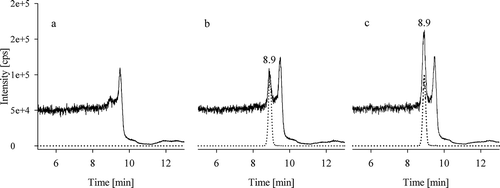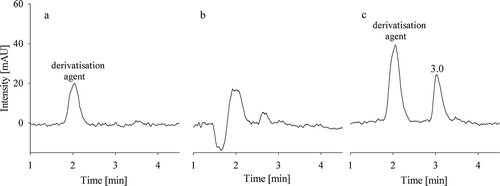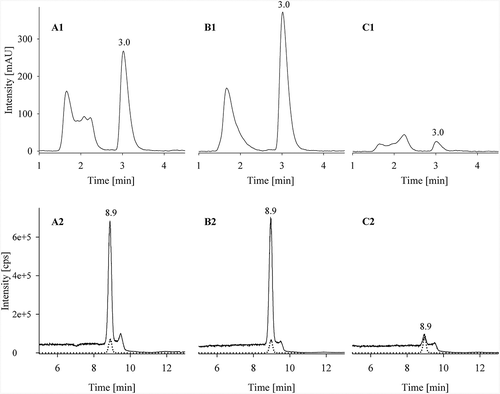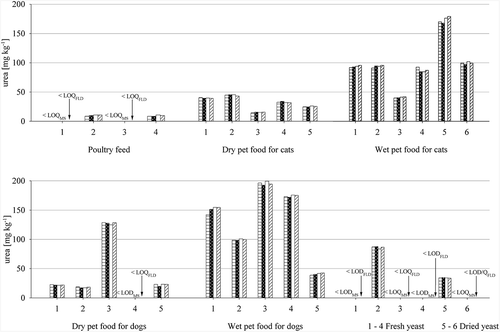Figures & data
Figure 1. Overlay of LC-MS/MS chromatograms of urea (m/z 61→44) as solid line and13C15N2-urea (m/z 64→46) as dotted line of (a) a water blank without internal standard, (b) a water blank with internal standard and (c) a standard solution with 0.4 mg l–1 urea in water

Table 1. Coefficient of variation (CV) and recovery rate of a 6-fold analysis of fortified samples with different fortification levels of urea using LC-MS/MS on two different LC-MS/MS systems and HPLC-FLD on two different HPLC-FLD systems
Figure 2. HPLC-FLD chromatograms of (a) a water blank with xanthydrol-derivatisation, (b) a cat feed sample without xanthydrol-derivatisation and (c) a standard solution with 0.4 mg l–1 urea with xanthydrol-derivatisation

Table 2. Results of a 6-fold analysis by LC-MS/MS and HPLC-FLD of ruminant feed from proficiency tests (PT) by the Association of German Agricultural Analytic and Research Institutes
Table 3. Coefficient of variation (CV) and recovery rate of a 6-fold analysis of fortified samples with different fortification levels of urea using an enzyme kit
Table 4. Results of a one-fold analysis of different matrices fortified with five different urea concentrations using an enzyme kit
Figure 3. Selected chromatograms for different matrices. Upper row: HPLC-chromatograms; Lower row: LC-MS/MS chromatogram overlays of urea (m/z 61→44) as solid line and13C15N2-urea (m/z 64→46) as dotted line. (A1/A2) 2 g dry complete feed for dogs (approx. 128 mg kg–1 urea) (B1/B2) 10 g wet complete feed for cats (approx. 173 mg kg–1 urea); (C1/C2) 2 g complete feed for turkeys (approx. 10 mg kg–1 urea); Approx. urea contents are given relative to a feed with a moisture content of 12 %

Figure 4. Comparison of LC-MS/MS and HPLC-FLD single measurement results for urea content of different feed and yeast matrices in mg kg–1 relative to a feed with a moisture content of 12 %; Horizontally striped bar: First LC-MS/MS analysis; black dotted bar: second LC-MS/MS analysis; white bar: first HPLC-FLD analysis; diagonally striped bar: second HPLC-FLD analysis; LODMS: 3 mg kg–1; LOQMS: 8 mg kg–1; LODFLD: 2 mg kg–1; LOQFLD: 7 mg kg–1

